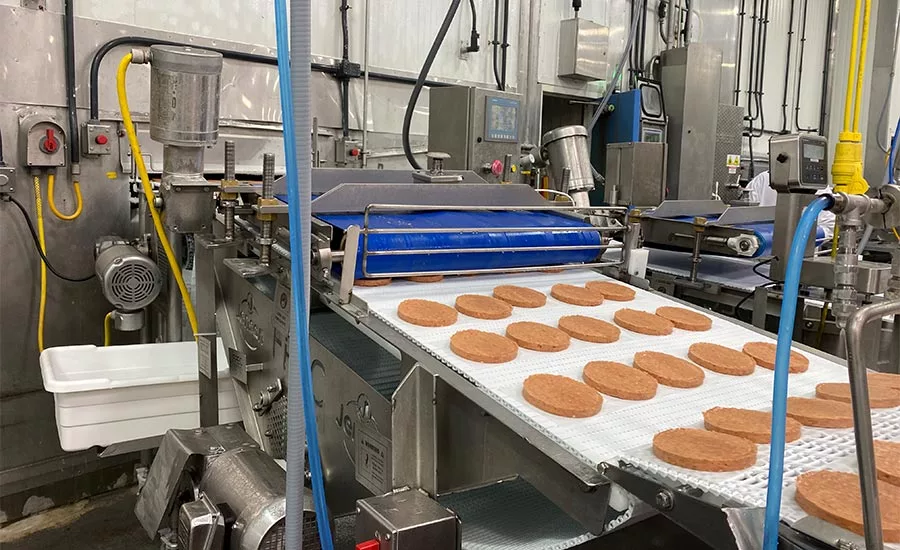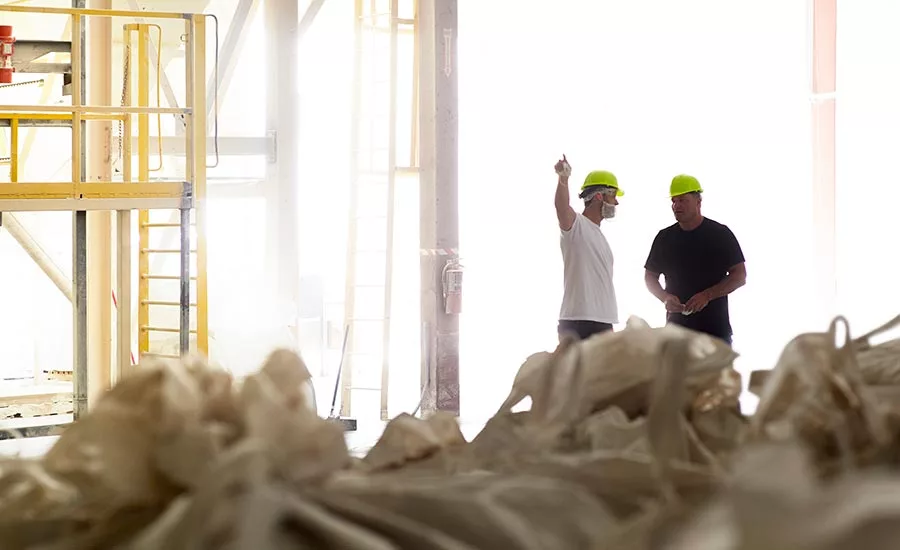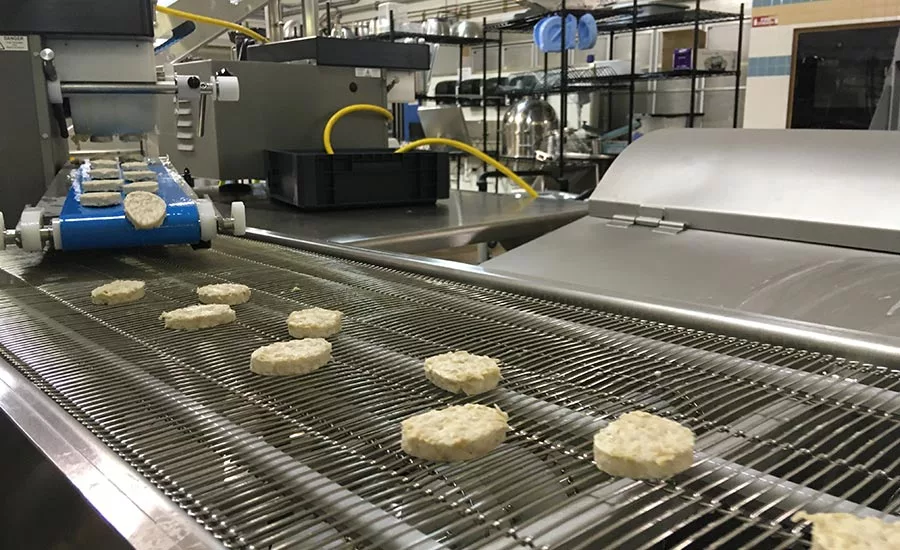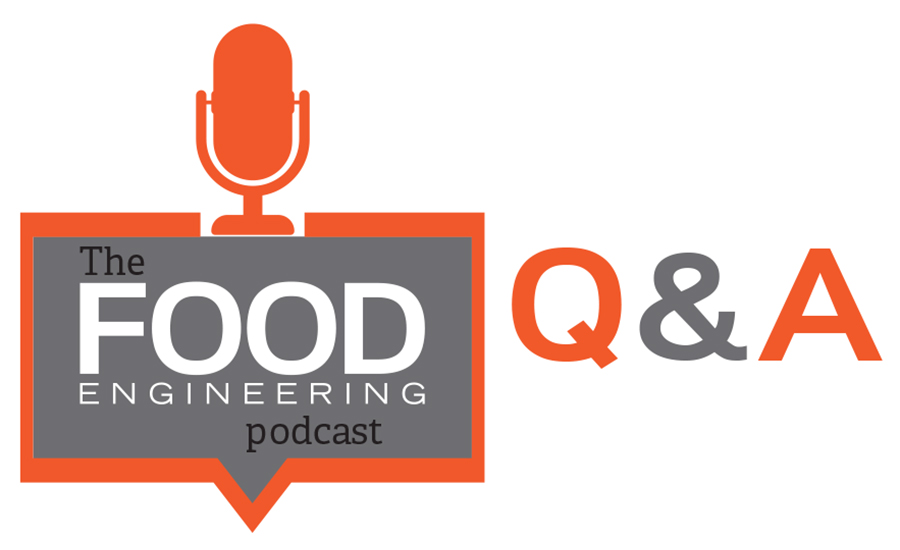Alternative protein market growth shows no signs of slowing
Consumer demand drives market to new heights; now processors are looking at what’s next

Before the Butcher produces plant-based burgers, chicken burgers, turkey burgers and sausage patties.
Photo courtesy of: Before the Butcher.

PURIS has partnered with Cargill and will be renovating multiple dairy facilities to use as production facilities.
Photo courtesy of: PURIS.

A Rebellyous Foods production line for its plant-based chicken nuggets.
Photo courtesy of: Rebellyous Foods.
The alternative protein market continues to grow, with companies ranging from start-ups to midsize to massive traditional protein producers all looking to get a piece of the pie.
The growth has been driven by a number of factors, but like any product, consumer demand is king. As more consumers have turned to alternative proteins in both foodservice and retail settings, the market has adapted to meet those needs.
But the factors driving those demands aren’t necessarily the same as traditional consumer priorities. While price still matters, many alternative protein products are and will remain more expensive in the near future than traditional protein. But health considerations, environmental impact and supply chain considerations are causing consumers to take a look at alternatives.
“We've seen this rapid expansion in the alternative protein category, and literally, there's a new player on the marketplace almost daily,” says Amy Shipley, managing director and partner, SRG. “What's different today than even six months ago where people's focus on the ingredient label, certainly supply chain, how things are being manufactured.”
William R. Aimutis, Ph.D., executive director of the NC Food Innovation Lab, works with start-ups and other companies to develop and pilot products. He agrees that the market is continuing to grow, with most of that growth being in meat. But the dairy market is also growing, and he points out that one developing trend is companies looking for different mixtures of proteins.
A lot of alternative proteins have been using or still use some kind of wheat gluten combination. But with gluten-free foods being a priority for many consumers, many alternative protein producers are looking to move away from glutens and looking at other proteins to mix with products.
“We are seeing a little bit more interest in chickpea,” says Aimutis. “We're seeing some rice protein coming into play. We're kind of anxious to see who's going to have the first real canola protein isolate get out there. And we're starting to see more in what I would call the fungal area, fungal analogy areas. Both those areas are starting to push hard, and make some inroads also.”
With the market firmly established, processors are now turning their eyes to what’s next. For a market such as alternative protein, with so many different combinations possible, that’s a very broad question. But both Shipley and Aimutis have some insights on where they expect the market to go.
“I think one of the challenges now are there are so many me-too products out there,” says Shipley. “I really want to see a lot more breadth amongst the companies, so you can really understand the differences between them, and I think that's going to be important in 2021 and 2022, is kind of carving out that unique niche. In '20 it was like, ‘OK, we all have the burger, we all have this, so what else is there? Why does yours taste better than others? Or why does yours perform better in certain cases from a cooking perspective, or whatever it might be?’”
Aimutis shares that perspective, but from a different angle, pointing out that there are certain market categories that may be primed for growth in alternative protein options.
“I think the next big milestone, frankly, would be just a greater variety of proteins in a sufficient quantity to be able to formulate into the mainline foods,” says Aimutis. “I think the dairy industry, and even the soy industry, to some extent, has been a little concerned about what would happen with a lot of these alternative proteins did get their supply chain proverbial act together. Would they creep into the market share that the dairy and soy have enjoyed? I definitely think we're starting to see that a little bit more now in peas.”
To get insights on where the alternative protein market is now, how it’s been affected by the events of the last year and where it’s headed, I spoke to a number of people in the industry. Q&As with the following people can be found by clicking on the links below. All Q&As have been edited for length and clarity.
Alternative protein Q&A
 Amy Shipley is managing director and partner, SRG, a Colorado-based consulting firm. SRG works with a number of clients in the alternative protein market.
Amy Shipley is managing director and partner, SRG, a Colorado-based consulting firm. SRG works with a number of clients in the alternative protein market.
Casey Laughman, Food Engineering (CL): We call this all "plant-based protein" or "alternative protein" or whatever, but it's not always the same plant. It might be soy-based, it might be pea-based, chickpea-based, it might be mushroom-based, so there really is that potential there for consumers to just kind of throw up their hands and say, "Hey, you know what? I know what's in this chicken package." So how is that making it a little bit harder for some of these companies to find their place in the market?
Amy Shipley, SRG (AS): I think it could be very confusing. And also, pea protein, there was a problem for a while. There was a shortage in terms of supply. And some consumers can really taste the pea protein. I know I can in certain products, depending on how much is used. You know, I think the advancement of using mushrooms, I mean, we've seen mushroom tea and a lot of different machine products, and we've certainly learned about the great benefits of using mushrooms.
It's gotten a little bit easier for consumers to understand, but I still think it's very confusing. It's how exactly are you using these products, and how exactly are they being treated? And it comes down to that notion that you spoke about a moment ago about, like, precision biology, which is kind of all the buzzword that everyone is using right now, and precision fermentation. And it's like, "what exactly is that?"
CL: One of the questions about alternative protein is traditional protein being from an animal, while alternative proteins can be created in a lab setting. I do understand how people can say, OK, well, this was grown on a farm or whatever, as opposed to this was created in a lab, but kind of at that fundamental cellular level, it's like there's not really a difference here.
AS: Exactly. Yeah, exactly. And I just think it's going to take time. Like anything, it's going to take time. I mean, again, the messaging, the positioning, the transparency, all of that is going to be really, really important. And it wasn't as important when we launched Impossible, and Beyond came on the market. It was so revolutionary and so exciting, and there was great messaging then, but those two really broke the glass ceiling for a lot of these companies that are coming on the market today, and I think that's great. And I think that there's a lot of room for continued advancements in science and technology that are going to help solve some of these food crises, but price is a major issue. Affordability, to me, is paramount in all of this. That's the long game.
CL: Right. I mean, we see it every time. Price ultimately is king. So, you've touched on a couple of different aspects of where you kind of see this market going, but is there one thing in particular that you see as the next evolution? Or is it kind of a combination of these things we've talked about, where it's the messaging, and getting the costs down, and things like that? What's the next big leap forward for this industry?
AS: I think it's around that kind of concept of precision biology and those advancements there. I think that's really important, and I think that's what's really going to happen, because it's just giving a lot of companies a lot of freedom to experiment with different ways to produce these products, and to get them precisely the way they want them to taste.
 William R. Aimutis, Ph.D., is executive director of the NC Food Innovation Lab, which works extensively with alternative protein producers and start-ups.
William R. Aimutis, Ph.D., is executive director of the NC Food Innovation Lab, which works extensively with alternative protein producers and start-ups.
Casey Laughman, Food Engineering (CL): The base of the market is kind of expanding more. Would that be accurate to say that you're seeing a lot of different combinations?
William R. Aimutis (WA): Yeah, I think that's fair to say. I think everybody is still trying to find the best alternative for gluten, especially because gluten has some very unique structural forming properties that we don't see with a lot of these plant-based proteins, outside of the wheat-based proteins, of course. But I think as people start opening up, and getting a more secure supply chain, on a lot of these alternative ingredients, that just encourages food formulators to work more with things other than gluten or pea protein.
CL: Right. That's one of the big challenges right now for everybody is finding out where your supply chain is strong, and where it wasn't because as the pandemic hit, and people were like, "Wait a minute, we thought this part of the supply chain was in good shape, but now all of a sudden we're scrambling." So, how has that affected the startup market? Has there been a lot of challenges there with supply chain issues and things like that?
WA: I think the biggest supply chain issues we've seen during COVID have really been more on the packaging side, and even on the supply side. And probably within the protein side. A few people were having some problems that were trying to use rice protein concentrates and isolates. There were some spot shortages, so to speak, there where I think stuff that was coming probably out of China just wasn't getting across the ocean. And then when it gets to the ocean, getting unloaded was a little bit of a problem for all of us.
So, sometimes we would run into some of that problem. It would take a little longer to get those proteins. But really the packaging in spices have probably been the bigger challenge we've seen. Packaging wasn't just flexible packages. It was glass. It was plastic. It was aluminum. Everything was getting hit on the packaging side it seemed like.
CL: You kind of had this two-pronged challenge of everything overseas was shutting down making it harder to get materials. And you also had this huge surge in retail demand. Everybody was trying to keep stuff on the grocery shelves. So yeah, I would imagine there was probably a big surge in demand for all kinds of packaging like you said?
WA: Yeah. And then when it would hit the shores at the docks, getting it off the docks, moving on either trucks or even rail, getting the longshoremen to unload the boats, to begin with, and then getting on the trucks, and on the rail was also a challenge there for a few months during the height of the pandemic. I think it's probably gotten a little better even though we're kind of seeing a little surge right now. It seems like it's not quite got the hiccups we had earlier.
CL: And then when we look at where the market is going, what's the next big evolution of alternative protein?
WA: I think the next big milestone, frankly, would be just a greater variety of proteins in a sufficient quantity to be able to formulate into the mainline foods.
 After a brief stint in the NFL, Tyler Lorenzen ended up joining the family business, which at the time was a grain- and seed-handling company. But Lorenzen’s father had long had the vision of ultimately turning PURIS into a plant-based food company, and Lorenzen joined PURIS to lead it to that stage.
After a brief stint in the NFL, Tyler Lorenzen ended up joining the family business, which at the time was a grain- and seed-handling company. But Lorenzen’s father had long had the vision of ultimately turning PURIS into a plant-based food company, and Lorenzen joined PURIS to lead it to that stage.
Casey Laughman, Food Engineering (CL): Traditional protein production is so resource-intensive. How much land you have to have, how much water you have to use, you have to have feed and pasture and hay and all that. So as people move more towards this idea of we really want to make sure that we're eating as sustainably as possible, then I think that does open up a big market for the plant-based protein market to say, "Hey, you know, this is nowhere near the environmental impact that a giant cattle ranch or a giant chicken farm is," or something like that.
Tyler Lorenzen (TL): One of the best stats for this from my perspective is chicken—being the most efficient animal-based meat—is about nine calories per pound, and that's about nine times more energy required to produce a chicken than plant-based. You start going up to beef and other commodities that require more and it starts really making it lopsided. But you start thinking about the amount of corn and soybeans that we grow in the United States and what we use them for, you know, 90 million acres-plus of corn every year, 80 million-plus acres of soybeans, and the large majority of that feeds animals. And so it's just very resource-intensive.
To give you a sense, there's a million acres of peas. I mean, this is huge, a huge industry. Is it going to change overnight? I don't think so, and I don't know if it should. Maybe a balanced approach to enable farmers to make a better profit, a better return, access to nutrition for all in a easier way and more affordable.
I think it still will provide a lot of this, and the plant-based industry is going to put a lot of pressure on the animal protein industry and I think there'll be new proteins that come out that will put pressure on plant. That's the beauty of what we do here in the United States and in this world is if we can create better ways and continually improve, that's better for everyone. And I think that's really what we're striving to do at PURIS is literally give farmers, makers, and eaters options and if they can start understanding their choices and how they're tied to outcomes in terms of environment, that's even better, but let's make sure they enjoy their food and that will help them make that choice over and over.
CL: Right, because when it comes down to it, you know, it doesn't matter how efficient your product is, it doesn't matter how environmentally friendly or sustainable or anything like that. If people don't like the taste, they aren't going to buy it again.
TL: That's right. Like, a plastic bag from Walmart—yes, plastic bags are not a good idea, so if we invent a new plastic bag from, peas, hemp, whatever, and it doesn't work, no one's gonna use it. It functionally has to work. And food, nutrition, and taste are key. And I think the other one is accessibility. I've said that a number of times. You have to be able to get it, and afford it, and it tastes good and give you the proper nutrition.
As part of its growth into an alternative protein company, PURIS has partnered with Cargill and will be overhauling two dairy facilities to turn them into production facilities to meet demand. Lorenzen sees that investment as part of the company’s larger mission to help support the communities it calls home as well as the markets it serves.
TL: In the end, we'll retrofit two dairy facilities and spend hundreds of millions of dollars to do it. Cargill's our partner and they're a huge player in the animal protein space, so they're helping us through all of this. And we have some other investors as well that, you know, taking assets that were invested in 30, 40 years ago and giving them a massive facelift and reusing the infrastructure and some of the things that matter. But really, it's right in these communities that tend to be forgotten about and with a lack of investment, they will be forgotten about. So we had to leverage our engineering teams and really create the best use case for facilities across the Midwest to give them new life, and we're not investing for a year or two. We're putting a 50-year life on these assets and extending what the future holds for them.
I think it's just getting started. You look at what's required in terms of actual amount of protein for the world and as the population increased, how we're going to fill the gaps to where we're at today to where we need to be. They say if we produce the same style of proteins that we have, the figure is about the same size of the United States is more land that we would need. Well, that obviously comes at a cost; we're not just going to create land. So what are we going to do? And we really need to be more efficient with the land that we have and it can't come at the cost for the environment. So you start thinking about well, what are the ways...?
 Danny O’Malley is president and founder of Before the Butcher, a manufacturer of plant-based burgers, chicken burgers, turkey burgers and breakfast sausage patties.
Danny O’Malley is president and founder of Before the Butcher, a manufacturer of plant-based burgers, chicken burgers, turkey burgers and breakfast sausage patties.
Casey Laughman, Food Engineering (CL): Obviously there's been a lot of upheaval over this last year, where you went from your foodservice business disappeared, retail has surged, then it sort of bounced back again. And now it's all up in the air again. But how has the market itself changed over the last couple of years? And how much of that change has been driven by consumer demand and growth and things like that, that you would expect to see versus everything that's going on right now?
Danny O’Malley (DO): Well, if we're referring back to a couple of years, we're referring back prior to COVID. And there was, clearly a significant annual increase in plant-based analogs, plant-based as a whole prior to that. And it was increasing in a manner that was difficult even for the producers to keep up with, which was clearly shown by some of the leaders in the industry. And their difficulties just scaling up fast enough to handle the volume of business that was coming in, in both foodservice and retail, and the opportunities, of course, internationally.
But COVID changed everything. I think we all learned quickly that we needed to adapt to something that we had never seen before. And those of us that were integrated into the foodservice market in a very integral way felt a dramatic impact, obviously. Retail was interesting. Foodservice took a dramatic hit overnight. Retail picked up quite a bit of that slack, but then there was a drop-off in retail too.
I think we get a little lost in foodservice too along the way because foodservice is so much larger than just what the average consumer sees. The average consumer sees foodservice as restaurant operations. But there's so much more; the schools, K-12, colleges and universities, corporate accounts, we did a lot of business with Google and Facebook and Yahoo and Uber. And they closed all of their cafeterias, that was business that has disappeared and really has not come back.
CL: When it became clear that this is going to be a long-term thing, and it was going to hit what is a big part of your business, how did you adapt to that? What was sort of the process of saying, "OK this is what we have to do now to literally survive as a company?"
DO: So we accelerated a process that was already starting for us. We had made our entry into retail in late 2019, November of 2019. And we were just getting our feet wet, I think we're in 600 or 700 retail locations in various parts of the country. So we continue to push on that to build our retail outlet for our products. And then we did a couple of other things, we were planning to get in e-commerce, we pushed that envelope and got in e-commerce perhaps a little bit earlier than we had originally anticipated doing. We've accelerated our goal to go after international business. And we're pursuing that as well. And we've had a lot of really great feedback on the international business basis. And this is the first year we began to sell to a couple of other countries.
But what's probably going to make the biggest impact for us in regards to the overall production of our products is industrial/ingredient-based buying. So we went after companies that are looking to make plant-based meals for retail basically. And, just like they would need their animal-based proteins, like if they're making a product and they need ground beef or chicken or pork. We are the ingredient supplier that will provide the plant-based beef alternative, chicken alternative, pork alternative. And that is where we're seeing the most promising opportunities to expand our business and grow the way we had initially planned in 2020.
CL: Okay, so that would be things such as the frozen meals you buy at the grocery store or something like that?
DO: Right, meals, soups, any kind of thing, like, that would require a plant-based, you know, alternative like ours as, you know, a substitute for animal-based meats. And there's a lot out there. I mean, if you're in the manufacturing business and you're making meals for retail, Costco, Sam's Club, Walmart, Kroger, Albertsons whatever you have.
If you're making meals, whether they're fresh, or they're frozen, or refrigerated, and you're looking at plant-based options to what you're already doing, you're going to look for somebody to provide the alternative protein for you. And we're a company that can do that. And we're really excited about the kind of feedback we've gotten in the companies we're working with right now and creating unique products for them to include in their meals that they're preparing for retail.
 Jim Alderink is VP, Technology Integration and Jonathan Jachimiec is CFO of MycoTechnology, a Colorado-based producer of mushroom proteins. MycoTechnology won Food Engineering’s 2020 Sustainable Plant of the Year.
Jim Alderink is VP, Technology Integration and Jonathan Jachimiec is CFO of MycoTechnology, a Colorado-based producer of mushroom proteins. MycoTechnology won Food Engineering’s 2020 Sustainable Plant of the Year.
Casey Laughman, Food Engineering (CL): What have you seen over these last couple of years, just in terms of how the market has grown and how it's gotten to the point of where it is now, what's driving that?
Jim Alderink (JA): Well, I think there's a load of things, some obvious and some less so. So, if you think about protein alternate, protein in general is up, right? It's up, fads and trendy diets are finding that...carbs are in a bit of a bad place right now and when you're talking about essentially four ways to get calories, fat, carbs, protein, and alcohol, something's got to go up when it goes down because we're not eating any less.
Some of the traditional sources of protein have gotten a bit of a black eye as well in terms of they bring great protein but they can bring baggage with them, whether it's cholesterol or fat, and we're talking meat, dairy and eggs here, allergenicity or sensitivity. Consumers are becoming much more sensitive and aware about their own health for a variety of really obvious reasons, with what's going on with COVID-19, and internet self-diagnosis is at an all-time high. So, some people jump to conclusions that it's dairy, in some cases, it is dairy or meat or whatever. So, they're looking for alternatives to lean into and different choices to try to rectify maybe health situation, or maybe it's about ethics and sustainability as well.
CL: You said something interesting there when you use the term fad because when plant-based protein first kind of hit the market, I think a lot of people sort of thought of it as, "OK, this is another one of those miracle diet type of things that, you know, it's going to die out in 6 months or whatever." But it hasn't because you have a lot of different things that you can offer in terms of being an actual replacement for chicken or beef or something like that, as opposed to being an add-on or something like that. So, it seems like the market definitely has a lot more legs because it's not trying to be a miracle cure type of thing, rather it's more of a lifestyle change, isn't it?
JA: Yes. And in some cases, it's been around a while now. If you look at the dairy category, alternative dairy, soy milks have been around for a long time and they've just stuck it out. And I remember reading an article in 2010 about how long can this last and here we are 10 years later and they're growing, many are growing.
And I believe it truly is because the headway that CPGs have made in making better food. The analogs now are as good or better than they've ever been from a taste perspective and no matter how you look at it, taste is king. If it doesn't taste great, I might buy it once and you might get a fragment of consumers that will stick with it because they're passionate about it. But general population, you buy it once and it's not good, you won't really buy it again.
CL: Jonathan, what have you seen over the last couple of years in terms of the market and business and things like that? And where do you see the next big jump coming for alternative protein?
Jonathan Jachimiec, MycoTechnology (JJ): When it comes down to it, and I think Jim will agree on this, is that there is a push for sustainability. There's definitely that sustainability push and two-thirds of customers are aware and wants to have a positive impact on the environment, about one-third of consumers, in general, tend to buy a more environmentally-friendly product. However, you know, that's where we are currently, for instance, in the burger wars, right? The meat analog burgers are sustainable, there's no doubt about that, right? You're not using beef.
But the next trend that adds to that is the health-conscious aspect to it. So, really looking at the ingredients, are those ingredients truly more healthy for you than a beef patty? And the biggest aspect of that is how many ingredients are on the label to create that burger? We know beef is one ingredient, add salt and pepper, you might have three. But when it comes to a vegan burger, you're looking at 20-odd ingredients to produce that. So, we see the trend is reducing the ingredients and ultimately ingredients that consumers are knowledgeable on in the product. So, the formulation is going to change over the years, so Myco has a big part in being able to help drive that change.
 Kristie Middleton is Vice President of Business Development for Rebellyous Foods. This interview is part of the Food Engineering Podcast Series.
Kristie Middleton is Vice President of Business Development for Rebellyous Foods. This interview is part of the Food Engineering Podcast Series.
Casey Laughman, Food Engineering (CL): What have you seen over the last couple of years, just kind of in terms of general growth and where it's positioned now compared to where it was two, three years ago?
Kristie Middleton (KM): Having been a vegan for over 20 years, I can tell you that plant-based foods are booming like never before. I certainly would have never predicted that we're seeing food manufacturers ranging from startups to established some of the world's largest meat companies, you know, consumer-packaged goods companies innovating rapidly in this category. It seems like it's a race to the top to see who can be the ones who are really shouldering this industry.
CL: It seems like that there's been so much more interest from consumers in a couple of different things here. I want to start with the health aspect of it. You know, as you mentioned, there are things like cholesterol-free, natural, and things like that, that just seems to be a much more important part of the consideration that people make now when it comes to making food choices, is that it's, in a lot of cases, it's still driven by cost, but also, they're looking for some of those healthier options and that takes precedence over cost.
KM: Right. I mean, the research indicates that what consumers look at when they go to the grocery store is convenience, cost, and taste. But, you know, if you're making decisions in advance or you become a routine consumer of something, the health aspect is really driving people to eat more plant-based foods.
It's uncanny to see that it's not just in the retail space but even restaurant chains like Burger King, or I saw recently that Jack in the Box was launching a plant-based chicken sandwich or at least trialing it, or KFC trialing Beyond Chicken, that's an indication that consumers are looking for the flavors that they're familiar with. They want to be able to go to the same restaurants, the same chains that they're used to going to, but they want to have something that's a little bit better for them and it's never been easier to do that than it is today.
CL: And then the second aspect of that is, over the last few years we've seen a huge increase in the number of consumers who want more information of the environmental impact of their food, where it's coming from, how the supply chain source, things like that. And as you mentioned, traditional meat production is very resource-intensive. So, how much of a factor do you think that is playing? What's kind of the difference between the resources needed to produce plant-based meat as opposed to traditional meat?
KM: Yeah, I mean, there's no doubt that producing animal-based foods is very devastating on the environment, from the crops that are grown to be fed to animals, to the transportation of those crops to get to animals, to the greenhouse gas emissions that come from factory farms. There's an abundance of evidence that animal-based food production has a much bigger carbon footprint than plant-based food production. Consumers are concerned about that, and in fact there was research that came out from Nielsen just last year that said that Americans, that 61% of Americans said that they would reduce their meat consumption due to concerns about the environment and 43% of them said that they would replace their meat consumption with plant-based protein types of alternatives. But what we really find is that, while there is concern about the environmental impacts and some people are motivated by that, really health tends to be the No. 1 motivating factor that's driving people to eat more plant-based foods, at least in the United States.
CL: Where do you see the market going over the next year, two years, five years, that kind of thing?
KM: Yeah, it's interesting and I wish I had a crystal ball, but I definitely see products like Beyond Meat and Impossible, which were, you know, we've had plant-based meats around for decades, some of them way better than others. But these products really disrupted the category by rolling out products that had the same look, the same taste, texture, and mouthfeel of meat, and that are being marketed to meat eaters, and of course that are also being displayed in the meat case right beside meat in some instances. So, I think we'll continue to see more such products that are really focusing on giving consumers that same experience that they're used to when eating an animal-based product, and that's certainly what we're going for at Rebellyous.
I think we'll also start seeing more value added products using plant-based food. That's been happening for a little bit, but in recent months, we've seen a lot of companies like Gardein, which is a plant-based meat producer that's been around for probably over a decade at this point, announcing that it's rolling out a new line of soups containing plant-based chicken. But also, other large established consumer-packaged goods companies are adding plant-based meats to their lineups like Lean Cuisine, which now has some of its more popular frozen ready meals that contain plant-based meats. And then I feel like we'll also see a lot more retailers that are rolling out their own line of plant-based foods. Kroger announced late last year that it was rolling out its own store brand of products from cookie dough that you would bake at home that's totally plant-based to plant-based meats and cheeses, and then just a couple of months ago announced that it was adding even more products to that line. So, I believe we'll see a number of more retailers who are doing the same thing, rolling out their store brands of plant-based foods to compete with other brands that are coming out every day.

Listen to the full interview here, or click here for more Food Engineering podcasts!
Looking for a reprint of this article?
From high-res PDFs to custom plaques, order your copy today!







